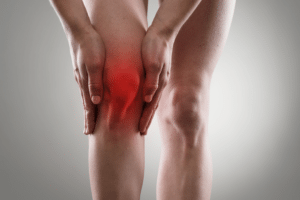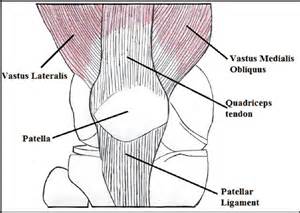What is patello-femoral pain syndrome
Patello-femoral pain syndrome is a term used to describe pain felt behind the knee cap (the patella). The patella lies within the femoral groove and normally slides up and down as the knee bends and straightens. When there is restricted movement of the patella it can become irritated as it slides across the surface of the femur. This irritation can result in pain and dysfunction during activities such as going up/down stairs, squatting, hopping and running. Patello-femoral pain syndrome normally has a gradual onset of symptoms rather than due to a traumatic event.

What causes patello-femoral pain syndrome:
Many factors can contribute to the onset of patello-femoral pain including muscle imbalance, poor biomechanics, growth spurts and sudden changes in physical activity.
The quadriceps muscle is attached to the patella with the vastus medialis oblique (VMO) muscle component responsible for pulling the patella inwards and the vastus lateralis (VL) muscle component responsible for pulling the patella outwards. If there is an imbalance between these muscles the patella can slide incorrectly.
Weakness in hip muscles can also cause patello-femoral pain due to poor knee control and shock absorption patterns.
Poor foot and ankle mechanics may also contribute to patello-femoral pain due to poor shock absorption and excessive tibial rotation.
What are the symptoms of patello-femoral pain?
The most common symptoms associated with patello-femoral pain include:
- Pain under or close to the sides of the patella.
- Low levels of swelling around the patella.
- Clicking or catching under the patella as the knee bends and straightens.
- Pain with repeated bending of the knee (eg. squats or going down stairs).
- Pain with prolonged bending of the knee (eg. sitting)
- A reduction in pain when the leg is relaxed in a straighter position.
Treatment of patello-femoral pain.
Physio Mainstay:
Research has shown that physiotherapy management of patello-femoral joint pain is very effective. A physiotherapy treatment program will be guided by the patient’s goals such as a return to sport and other functional activities and can incorporate many of the following strategies:
- Modified rest from activities that are aggravating.
- Muscle re-training to strengthen the quadriceps, hamstrings and hip muscles.
- Taping is often an effective short-term solution to reduce pain.
- Foot biomechanics will be addressed.
- Addressing tight structures with release techniques.
- Addressing biomechanical movement patterns specific to your activities.
Adjunct therapy options:
If warranted orthotics may be recommended to assist in your symptoms. Patello-femoral joint pain that is due to more extensive biomechanical changes, such as bony changes, may need surgery to assist in the longer term management of symptoms.
Differential diagnosis:
- Patella subluxation or dislocation
- Referred pain from the hip or lumbar spine
- Pain arising from the structures in the knee such as the meniscus.
- Inferior fat pad irritation
- Plica irritation
- Saphenous nerve dysfunction.
5 tips for self-managing or fixing your patello-femoral joint pain:
- Modifying activities that increase your pain can be great for getting a quick reduction in pain. This may be as simple as not going as deep when squatting or having a slighter wider foot stance.
- Using ice after activities can also be great for quick pain reduction.
- Make sure you have good mobility of your quadriceps muscle by doing stretches for the quadriceps or using a foam roller.
- Ensure you have good ankle mobility by completing calf stretches.
- Seek assessment from a physiotherapist if your symptoms continue as there are so many different factors that can contribute to knee pain and we only have 5 points available here!

